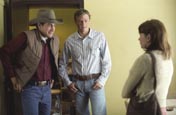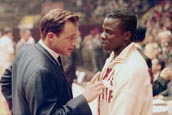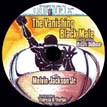Brokeback Mountain
•
Crouching Cowboys, Hidden Boyfriends
In 2001, Ang Lee probably deserved to win both the Best Picture and Best Director Academy Awards for Crouching Tiger, Hidden Dragon, a magical Chinese fable which blended elements of history, romance and martial arts into an unforgettable, surreal adventure. And although Ang has imbued Brokeback Mountain with some breathtaking cinematography, his tortoise-paced chick flick is simply too slow to unfold to hold an audience’s interest.
On my way into the theater, the usher whispered, “It’s okay if you want to leave early,” as he tore my ticket in half. “You don’t have to stay till the end.” Initially, I assumed he was referring to the latter-day cowboy flick’s homo-erotic theme. But after about an hour of setting the tone against the backdrop of a sweeping Wyoming, “Big Sky” panorama, I found myself squirming in my seat and checking my watch every five minutes while waiting for something meaningful to transpire on screen.
But Brokeback Mountain, which might have been better named Bareback Mountain, takes its own sweet time to spin a tale of forbidden love between a couple of handsome cowboys who look like the Marlboro Man and one of the Village People. Loosely-based on the E. Annie Proulx short story of the same name, the film stars Heath Ledger as Ennis Del Mar and Jake Gyllenhaal as his secret lover, Jack Twist. 
Their 20+ year affair starts in the Sixties, when the two were hired to guard a herd of sheep, 24/7, on a picturesque hillside far from civilization. Their typically macho exchanges and gruff exteriors eventually melt the night the pair finally decides to share a tent. Rough sex ends with tender canoodling, though both have second thoughts the morning after.
“This is a one-shot thing we got going on here,” Ennis warns. “You know I ain’t queer.”
“Me either,” Jack responds.
Yet, despite the distance that their subsequent marriages and the arrival of children would bring, they proceed to embark on one of the most passionate and enduring relationships in screen history. Hiding their true sexual preferences, the gay cowpokes still find a way to make time for illicit liaisons, mostly back where it all began up on Brokeback Mountain.
This bittersweet, latter-day Western focuses wistfully on what could have been, rather than on what Ennis and Jack actually have, for the film frequently implies that both would have been better off had they found the strength to come out of the closet, abandon their responsibilities, and shack up.
Meanwhile, the movie fails to address adequately the question of whether such a selfish indulgence might ruin the lives of their wives and kids. Thus, it conveniently ignores all the very serious fallout visited upon the innocent victims of guys “on the down low” like we see regularly discussed on TV talk shows such as Oprah and Dr. Phil.
In sum, Brokeback’s unapologetically gay agenda aggressively implores us to celebrate homosexuality for homosexuality’s sake. While this approach turns out to be a tad too simplistic for my taste, this cowboy flick’s fatal flaw rests with its extolling the virtues of man-on-man mating to the point of its just being boring.
The Misfits updated as a gender-bending melodrama.
Rating: R for expletives, violence, nudity and graphic sexuality.
Running time: 134 minutes
Studio: Focus Features
Glory Road
No Stars
Historic NCAA Triumph Recast as Revisionist Biopic
I had my suspicions about Glory Road even before I saw it, because I felt like I was being discouraged at every turn from covering the picture. When I asked for an electronic press kit, I was sent a cassette in beta format. Plus, it was for some other film that opened last year. Then, when I tried to attend an early screening, the good folks at Disney were too busy to help me in that endeavor by arranging for a pass. So, when I showed up anyway and simply informed the theater that I was a critic, the manager flat out lied to my face and said that Glory Road wasn’t showing that night. 
Rather than create a scene, I decided to wait patiently for the picture’s release. And now, after finally seeing the movie, I think I understand the reason for the whole charade. The studio was banking on the “pump-and-dump” marketing strategy whereby it hypes a flick with strategic advertising to get as many suckers in the seats that first weekend before word spreads via reviews and the grapevine.
Via commercials and an ESPN special which have heavily-saturated the airwaves, Glory Road has been carefully promoted as a period piece which recounts the 1966 NCAA Basketball Championship Game upset of the heavily-favored, lily-white, Kentucky by lowly Texas Western, an unheralded underdog with five Black starters. The movie is based on the book of the same name by Don Haskins, the coach who took Texas Western to the top that glorious season.
But is it okay to run roughshod over history, as long as you’re making a feel-good period flick? I don’t think so, and Glory Road simply takes way too many liberties with the truth to take seriously. First, it presents Haskins, as played by Josh Lucas, as a white Martin Luther King who unilaterally integrated college basketball while pulling off a miraculous victory.
Truth be told, he didn’t even integrate his own team, as it already had three African Americans players when he took the job. In fact, Texas Western had been recruiting Black kids since the mid-Fifties. So, an early scene in which an angry college administrator utters the N-word in disgust while confronting Haskins over the “new” ethnic make-up of his team makes no sense.
Just as ludicrous is how the new coach is shown as going from heading a girls’ high school team to winning the NCAA Championship in less than a year. In reality, he was hired in 1961, which means it took him five years to turn the team around.
Equally as unlikely is the fashion in which his players are presented as insulting stereotypes whose only hope in life rested with being plucked from the ghetto and whipped into shape by their great white savior. For instance, one of them, Willie Cager (Damaine Radcliff) basically boasts about being a nitwit, putting himself and his people down by informing his geology professor, “I’m a Black man. I don’t do rocks.” Prefacing this remark by referring to his skin color makes a not-so-subtle inference that African Americans are anti-intellectual.
The caring coach comes to the rescue, and puts in a call to Willie’s mother (Valeri Ross), a sassy “Mammy” who soon arrives on campus and proceeds to sit behind her son in class to make sure he pays attention. The other Black ballplayers have their own embarrassing flaws, too. This one’s a Tequila-swilling alcoholic, that one’s a womanizer who boasts about having 50 or 60 girlfriends, et cetera.
If these characterizations were true, I doubt that Texas Western would have ever achieved its feat which, by the way, was not the greatest upset in the history of NCAA basketball, as claimed, here. Both TW and Kentucky (which starred future NBA coach Pat Riley) entered the contest sporting identical 27-1 records. Kentucky was ranked #1 in the nation, TW, #3. So, there have been plenty of more shocking outcomes in the annals of college sports, both before and after.
In closing, let me mention another one of my pet peeves, namely, how Hollywood has to lace any African American drama with elements of comedy, as if Black people find everything comical, even integration. It’s funny that none of the other docudramas currently in theaters, like Munich, Capote, Syriana or Good Night and Good Luck, undercut their plot’s tension with copious servings of comic relief.
Had I cared enough to sit through Glory Road’s closing credits, I understand that some of the real life Texas Western team members appear to share their heartfelt recollections. Too little, too late.
I wonder how they feel that about their movie having so many ethnic slurs, profanity, and gory violence and still landing a PG rating. Probably disappointed, especially if, like most folks, they were expecting a dignified, uplifting cross of Remember the Titans and Coach Carter, not clown-like impersonations of The Harlem Globetrotters.
Rated PG for profanity, ethnic slurs, graphically-depicted, bias-crime violence, sexual situations and mature themes.
Running time: 106 minutes
Studio: Buena Vista Pictures
The New World
•
The Thin Red Squaw
Are you familiar with the legend of Pocahontas? If so, you might not recognize the impressionistic, imaginative version of the tale told in The New World. This novel re-interpretation was both written and directed by Terrence Malick, a two-time Oscar-nominee for The Thin Red Line.
Historians generally concur that Pocahontas was born Matoaka (1595-1617), but was given the nickname Pocahontas (Algonquin for “little wanton”) as a child because of her playful nature. This energetic Indian princess was the daughter of Powhatan, chief of the tribe which resided in the Tidewater region of Virginia at the time the English first arrived in May of in 1607.
In December of that year, Captain John Smith (1579-1631) was leading an expedition about a dozen miles away from their fort at Jamestown, when he was captured by Native Americans and almost executed. However, he was saved by the intervention of then 12-year old Pocahontas. His spunky savior was subsequently welcomed as a frequent guest at the British colony, a second home where she made friends with other children. 
As Red-White relations worsened, the young girl came to play a critical role in the survival of the early settlement, as she supplied its starving inhabitants with sufficient provisions to stave off extinction. In 1609, Smith was badly wounded in a gunpowder explosion, and returned to England for medical treatment.
In 1610, Pocahontas married a fellow native (who this flick makes no mention of) but was soon kidnaped by the colonists. A few years later, she converted to Christianity, was baptized Rebecca, and married John Rolfe (1585-1622), a very religious tobacco farmer. She bore this second husband a child before the family was summoned to London for an audience with King James I in 1616. Seven months later, Pocahontas fell ill during the return trip and succumbed to pneumonia before the ship landed back in Virginia.
That’s the not so sexy factual details of Pocahontas’s terribly tragic life. By contrast, Terrence Malick’s slant reweaves the horrible into a hyper-romanticized Hollywood account. The New World shows the maverick director as still having a penchant for the sort of highly-stylized cinematography which marked The Thin Red Line. That inscrutable adventure made the battle of Guadalcanal look like a bummer of an LSD trip, unfolding as indescribable scenes of graphic bloodletting periodically punctuated by surreal, disembodied reflections on the insanity of it all.
This film features a similar absence of structure, plus it presents a completely overhauled heroine likely to infuriate history buffs interested in accuracy. As played by Q’Orianka Kilcher, Pocahontas is no longer a carefree playmate of children, but a seductive nymphet whose manifest destiny to wed the hunky, hirsute John Smith (Colin Farrell) is aborted when the 28 year-old conqueror abandons both her and the Americas after less than two years.
The precocious prepubescent pines away for Smith anyway, unable to get the love of her life out of her head till being inaccurately informed that he has passed away. This leads the reluctant renegade to the regrettable decision to marry Rolfe (Christian Bale). But the omniscient narrator (John Hurt) telegraphs the inevitable resurrection, and the film marches laboriously, obviously, and inexorably to an anti-climactic, short-lived reunion, followed by a bittersweet finale which makes one wonder exactly what the point of the whole picture was.
An admittedly artistic, two-and-a-half-hour cinematic mosaic meant by Malick more as a monument to himself than to the misrepresented maiden it presumes to memorialize.
Rated PG-13 for graphic battle sequences.
Running time: 150 minutes
Studio: New Line Cinema
On the Outs
• • • •
Trio of Troubled Latinas Linked by Lawlessness in Super-Realistic Slice-of-Life Drama
Seventeen year-old Marisol (Paola Mendoza) is a drug-addicted, single-mom with a fragile psyche who divides her time between fighting her demons and fighting with the foster care system for custody of her baby. Oz (Judy Marte), also 17, is a tough tomboy who deals drugs in the same Jersey City slum. And sheltered Suzette (Anny Mariano), 15, resides in the neighborhood, too, and it looks like her attraction to a ghetto gangsta (Don Parma) will land her on he wrong side of the law.
In fact all three of these Latinas eventually end up behind bars, and this is what links their parallel, if ill-fated, paths in On the Outs, a super-realistic slice-of-life drama directed by Lori Silverbush and Michael Skolnik. Based on the true cases culled from juvenile courts, this movie sensitively portrays the perilous predicament of girls growing up in today’s inner city.
Shot documentary style against graphic urban backdrops in gritty environs, the movie is nothing if not convincing in delivering a gripping authentic air. The leads, besides being extensively easy on the eyes, are all first-rate actresses, which means you tend forget that this is fiction. And the supporting cast, comprised almost exclusively of amateurs discovered on location, is almost as good.
Combining all of the above with three engaging storylines, in-your-face cinematography, and a sobering message makes On the Outs a female empowerment flick not to be missed.
Rated R for pervasive profanity, ethnic slurs, street violence, graphic depiction of drug addiction, premarital sexuality, teen pregnancy and mature themes.
Running time: 86 minutes
Studio: Polychrome Pictures
Why We Fight
• • • •
The Military Industrial Complex Examined in Damning Documentary
In his nationally-televised farewell address delivered on Jan. 17, 1961, outgoing U.S. President Dwight D. Eisenhower warned the country of the coming emergence of the Military Industrial Complex. Despite being a Republican and a retired four-star general, Eisenhower sensed that the Department of Defense was likely to wield a disproportionate amount of power in the not too distant future, a sad sate of affairs for a representative democracy.
Today, we see that those fears were not unfounded, as America spends more money on the military than on all other federal expenditures combined. Thus, priorities are being set by defense lobbyists based on what will benefit war profiteers as opposed to what will benefit the citizenry.
These hard, cold truths are exposed in Why We Fight, a damning documentary directed by Eugene Jarecki (The Trials of Henry Kissenger). Winner of the Grand Jury Prize at last year’s Sundance Film Festival, the movie interweaves file footage with running commentaries by a “Who’s Who” list of both liberal and conservative luminaries such as Senator John McCain, Gore Vidal, Richard Perle, and Bill Kristol.
The neo-cons, of course, rationalize away U.S. imperialism as a categorical imperative, while Department of defense detractors point to frightening trends, such as the fact that the Pentagon now devotes over a billion dollars a year to recruitment alone in this age of the all-volunteer army. Perhaps the most disillusioning prospect painted by this pessimistic picture is the expectation of further unprovoked invasions in the name of “freedom” and “democracy,” since in a profit-driven, capitalist society, the more lucrative war becomes, the more war will be mandated by Wall Street which is interested only in the bottom line.
Rated PG-13 for brief profanity and gruesome war images.
Running time: 98 minutes
Studio: Sony Pictures Classics
|
|
The Grace Lee Project
• • • •
Documentary Director in Search of Other Asian Namesakes
It never occurred to Korean-American Grace Lee while growing up in her rural Missouri hometown that she might have a very common name. But then when she left the Midwest to live in New York and then California, she was surprised to discover that nearly everyone she met had not only once known another Grace Lee, but they also seemed to have a similar narrow opinion of her.
Each of these new acquaintances would invariably describe their Grace as modest, nice, quiet, smart, passive, accomplished, and Christian. Intrigued by this strangely similar image of her namesakes as members of a virtual sorority of super-Asians, the aspiring moviemaker decide to track down some other Grace Lees to see just how much they all really have in common.
The upshot of her efforts is The Grace Lee Project, a full-length documentary, and as engaging and fascinating a film as you could hope to find. She focuses her camera on about 35 extraordinary women named Grace Lee who are actually extremely different from each other, despite frequently sharing some of the same deep cultural roots.
We learn that most had been pressured to be church-going, academic-oriented bookworms, raised under parental pressures to measure up to the Asian-American stereotyping as a model minority. Still, they blossomed into unique individuals, such as the Grace who tried to burn down her high school, the Grace who makes voodoo dolls of her enemies, or the director herself, who admits to being a relative underachiever and an avowed atheist.
Then there’s Grace Lee the CBS news anchor in Hawaii who says she would never have made it in television if she had merely been meek and deferential. The same can be said of Grace Lee the L.A. car dealer, an extrovert who appears in her own TV commercials.
My personal favorite was Grace Lee Boggs, an outspoken octogenarian from Detroit. Known in the ‘hood as “Grace X” because of her decades-long commitment to the Black Power Movement, this fiery community activist continues to work with youth around the city, inspiring them with quotes from Frantz Fanon like, “Each generation must, out of relative obscurity, discover its mission, fulfill it or betray it.”
Whether or not you knew a Grace Lee before, you’ll never be able to think of Asian females as a type again after getting to know the ensemble comprising this enlightening and enriching bio-pic.
Excellent (4 stars)
Unrated
Running time: 68 minutes
Distributor: Film Forum/Women Make Movies Productions
Henri Cartier-Bresson: The Impassioned Eye
• • •
Bio-Pic Looks at Life of Legendary French Photographer
The career of Henri Cartier-Bresson (1908-2004), the legendary photojournalist, spanned most of the 20th Century. After focusing first on Africa in the Twenties, he went on to cover the Spanish Civil War, the liberation of his beloved Paris at the end of WWII, a prophetic Mahatma Gandhi just moments before his assassination, and the rise of the communists in China. He was also commissioned to do portraits of plenty of famous faces, including such celebs as Truman Capote, William Faulkner, Alexander Calder, and Coco Chanel. 
This bio-pic is basically a photo exhibition accompanied by some interesting interpretations of his pieces by the reclusive artist himself, plus some gushy reflections on his work by actress Isabelle Huppert, author Arthur Miller, and others. In America, the intrepid shutterbug immersed himself amongst the poor to capture an assortment of telling shots, whether of sharecroppers in Mississippi or contrasting poor folks along the Potomac with the backdrop of the D.C. skyline.
Not a particularly overtly political documentary, yet effective, given that Monsieur Henri was most definitely blessed with an eye for freezing reality via the magic of still photography. As he so eloquently describes his life’s calling, “It is putting one’s head, one’s eye, and one’s heart on the same axis.”
Unrated
In French and English with subtitles
Running time: 72 minutes
Studio: Palm Pictures
How to Eat Your Watermelon
in White Company
(And Enjoy It)
• • • •
Melvin Van Peebles Career Chronicled in Brash Bio-pic
Melvin Van Peebles is truly a Renaissance Man, having not only acted in, but sang, produced, edited, and written scripts and scores for both movies (Sweet Sweetback’s Badass Song) and Broadway plays (Ain’t Supposed to Die a Natural Death). He probably first found fame in 1970 when he directed a comedy called Watermelon Man for Columbia Pictures.
But he really made his seminal contribution to cinema a year later with Sweet Sweetback’s Badass Song, an independent flick he shot on a shoestring budget. What made this movie so remarkable was that it grossed over $10 million dollars at the box office without studio backing, thereby proving to Hollywood that there was a market for Black oriented entertainment. However, where Sweetback presented African Americans with dignity, intelligence, and political awareness, the Blaxploitation Era which ensued was marked by pictures filled with pimps, hustlers, whores, and all sorts of sorry stereotypes.
How to Eat Your Watermelon in White Company is a brash bio-pic which chronicles the life of Van Peebles, warts and all. It shows the feisty 73 year-old to be as irascible as ever as he explains how, frustrated by racism in America, he abandoned the U.S. for France at an early age. Overseas, his artistic endeavors were encouraged and developed before the expatriate eventually returned home with a determination to get his projects done, come hell or high water.
Among the many luminaries making appearances in the picture are Melvin’s son, Mario, filmmaker Spike Lee, photographer Gordon Parks, and musician Gil Scott-Heron. But the irrepressible Van Peebles doesn’t really need all the accolades, as this edgy documentary easily convinces the viewer of its subject’s considerable genius, as a role model who managed to maintain his integrity, and to make a buck while thumbing his nose at a racist system designed to suppress his revolutionary ideas.
Unrated
Running time: 85 minutes
Studio: Film Forum
Munich
• • • •
Israeli Hit Squad Tracks-Down Terrorists in Espionage Thriller
Despite the fact that Hitler had stripped Jews of their citizenship just a year earlier, the International Olympic Committee decided to allow Berlin to host the Games during the summer of ’36. And the absence of a reaction on the part of the United States and other participating nations only served to fuel the subsequent Nazi expansion which eventuated in World War II and the Holocaust.
For this reason, the whole world was watching Munich in ’72, the first occasion on which the Games would again be staged in Germany. Optimistically billed as “The Olympics of Serenity,” its consciously-cultivated aura of peace and harmony was irreversibly shattered in the wee hours of the morning of Sept. 5 when a Palestinian Liberation Organization (PLO) extremist group dubbed Black September stormed the Israeli compound.
By the time the ensuing, tense standoff ended with a bloody shootout about 20 hours later after a badly botched rescue attempt, 11 Israelis hostages, 1 policeman, and 5 of the terrorists lay dead. “They’re all gone,” was the ever-echoing refrain uttered by stunned, ABC-TV anchorman Jim McKay when he went on the air to inform the public. 
Munich, an emotionally-engaging, espionage thriller directed by Steven Spielberg, revisits the retribution eventually exacted in the aftermath of that awful tragedy. Based on the 1984 best seller Vengeance: The True Story of an Israeli Counter-Terrorist Team by George Jonas, this riveting tale was previously adapted into a made-for-TV movie entitled Sword of Gideon.
With a plotline more similarly-structured to the HBO production than the original source material, this version stars Eric Bana (The Hulk) as Avner, the Mossad agent personally tapped by Prime Minister Golda Meir (Lynn Cohen) to lead a team of five assassins sent on a top secret mission to track down and kill the masterminds of the Munich massacre. Out of a sense of patriotic duty, this son of a war hero accepts the assignment, leaving behind a young wife (Ayelet Zurer) who is seven months pregnant with their first child.
Relying on the limitless funds provided by Ephraim (Geoffrey Rush), the only Israeli intelligence officer he is permitted to contact, Avner adopts a new identity and assembles a hand-picked task force of a highly-skilled experts. This includes Robert (Mathieu Kassovitz), a Belgian bomb-maker; German-Jew Hans (Hanns Zischler), a crack forger and document expert; Carl (Ciaran Hinds), a crime scene sweeper who coolly cleans up after each hit; and Steve (Daniel Craig), their South African getaway driver.
Understanding that, if caught, Israel would disavow any connection to them, the quintet quickly disappears deep undercover. They embark on a operation which has them crisscrossing Europe with stops in Geneva, Frankfurt, Rome, Paris, Athens, Cyprus, Holland, and London, before returning to the Middle East.
What makes this movie so remarkable and far more compelling than a typical, political
potboiler is the degree to which the personalities of the principal characters are
detailed and developed. For ever so subtly, Spielberg masterfully conveys the toll
which the inordinate tension of their job and the mechanics of their methods take on his subjects’ souls.
Adrift, away from friends and family for months and months on end, the fallout of the job is evidenced by an erosion of moral bearings, and intermittent questioning of the whether an eye for an eye and a tooth for a tooth is the right response to terrorism. Though spiritually transformed in unanticipated ways, missing loved ones, and plagued, alternatively, by both disgust and self-doubt, they persevere, in spite of the discouraging realization that they have somehow been discovered by the enemy, and are now, too, being hunted one-by-one.
A most-profound morality play which essentially expounds upon an elemental Biblical passage.
Rated R for explicit eroticism, expletives, nudity, graphic violence, and sex-linked gore.
Running time: 164 minutes
Distributor: Universal
The Vanishing Black Male
• • • •
Documentary Explores Issue of Disappearing African American Men
Because the ratio of Black females to Black males has been steadily increasing in African American communities all across the country, many folks have begun to wonder, “Where have all the brothers gone?” This thought also occurred to director Hisani DuBose who decided to pose the same question to a variety of experts and ordinary people from all walks of life to see whether they’ve noticed the trend towards extinction and what they make of it.
The upshot of DuBose’s efforts is The Vanishing Black Male, a thought-provoking documentary essentially comprised of a series of informative interviews on the subject . What makes this movie so valuable is that each contributor brings a different set of life experiences to the table, and addresses the issue in a heartfelt manner from his or her own particular perspective. . What makes this movie so valuable is that each contributor brings a different set of life experiences to the table, and addresses the issue in a heartfelt manner from his or her own particular perspective.
Refreshingly honest in tone, don’t expect any candy-coated aphorisms or simplistic solutions here. Among the picture’s memorable contributors are politicians, a shrink, a social worker, a pastor, firefighters, educators and students, and more. The diverse panel’s standouts include Sgt. Delacy D. Davis of the Black Police Officers Against Brutality and Dr. Duane Dyson, M.D., Executive Director of The Violence Prevention Institute.
Davis speaks eloquently about the negative effects of advertising, the breakdown of the Black family and about his organization’s effort to support single-moms and their kids in an effective manner. Dyson, meanwhile, stresses the importance of elementary school education while indicting the suicidal nature of the ghetto gangsta mentality. As an emergency room physician in an inner-city hospital, he has witnessed, first-hand, gunshot victims on a daily basis. And he soberly informs us that all of the wounded and dying young males arrive stripped of their macho veneers by the time they end up on his operating table.
Overall, along the way, we learn that guns, the street, failing schools, drugs, the criminal justice system, absentee fathers, suicide, unemployment, and a host of other factors are all contributing to the phenomenon of Black male extinction. And while the daunting dilemma does appear to be overwhelming, the concern exhibited in the conversations do provide considerable reason for hope. For it is inspiring to hear the sage reflections of so many who share a dedication and determination to alleviating the same pressing problem.
Designed with every demographic in mind, The Vanishing Black Male is a remarkable movie not to be missed by young or old, by male or female, by Black or white or anyone with an interest in a frank discussion of the future of African American men. This critic’s pick for the Best Documentary of 2005.
Unrated
Running time: 80 minutes
Studio: Seven Generations Productions
To order a copy of The Vanishing Black Male, visit: http://vanishing.indie-dvd.net
South African Drama To Open Pan African Film And Arts Festival In February
South Africa’s official nomination for the 78th Annual Academy Awards® in the foreign language film category, TSOTSI, has been selected as the opening night film for the 14th Annual Pan African Film and Arts Festival.
Set amidst the sprawling Johannesburg township of Soweto - where survival is the primary objective - TSOTSI traces six days in the life of a ruthless young man who ends up caring for a baby accidentally kidnaped during a car-jacking.
TSOTSI is a gritty and moving portrait of an angry youth living in a state of extreme urban deprivation. His world pumps with the raw energy of "Kwaito music" - the modern beat of the ghetto that reflects his troubled state of mind.
The film is a psychological thriller in which the protagonist is compelled to confront his own brutal nature and face the consequences of his actions. It puts a human face on both the victims and the perpetrators of violent crime and is ultimately a story of hope and a triumph of love over rage.
"Tsotsi" literally means "brute" in the street language of South Africa's townships and ghettos. "Kwaito" is South African hip hop.
The star-studded event will be held at 7 p.m. on Thursday, Feb. 9th at the Directors Guild of America with principal cast and filmmakers in attendance. The evening will be hosted by acclaimed filmmaker and actor Forest Whitaker. PAFF’s annual gala after party will follow the screening and be held at the
Directors Guild of America which is located at 7920 Sunset Blvd. in Los Angeles. Tickets are $150 For sales and more information, call 323-295-1706 or visit www.paff.org.
|
